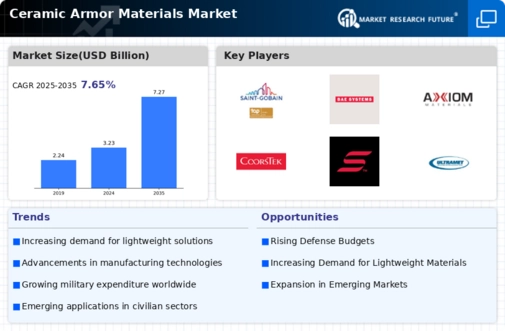Market Share
Ceramic Armor Materials Market Share Analysis
The Ceramic Armor Materials Market, which improves protection and security, uses market share positioning methods to compete. Companies often differentiate by creating sophisticated ceramic armor materials. This may include increased strength, lightweight, and ballistic resistance. Companies provide different benefits to create a market niche and attract customers seeking specialized solutions. Pricing methods to gain market share are also important. Some firms use cost leadership to make ceramic armor materials cheaper than rivals without sacrificing quality. The lower costs make their items more appealing to budget-conscious buyers. Others pitch their ceramic armor materials as high-end, high-performance items and charge premium prices. This attracts quality-over-price clients, increasing company margins. The Ceramic Armor Materials Market needs market segmentation also. Companies adjust items to end-user demands by analyzing their various wants. Military ceramic armor materials may vary from law enforcement or civilian ones. By knowing each segment's needs, organizations can focus their marketing and serve more consumers, increasing their market share. Strategic partnerships and collaborations are growing in ceramic armor materials. firms typically partner with academic institutes, military groups, and technological firms to exchange knowledge, resources, and expedite product development. These alliances boost innovation and open new markets and customers. Companies may gain market share and a competitive advantage by strategically associating with industry leaders. Market share positioning also depends on marketing and branding. Companies spend money on brand image that expresses dependability, quality, and innovation. This improves consumer impression and market trust. Marketing methods include targeted advertising and industry gatherings boost brand awareness. Companies may increase market share and attract new consumers by associating the brand with high-quality ceramic armor. Research and development are essential in the competitive Ceramic Armor Materials Market. Companies must spend in research to enhance goods or develop new ones as technology advances. This maintains their market share and makes them industry leaders. Companies may accommodate changing client requirements and stay competitive by regularly upgrading ceramic armor materials. In conclusion, the Ceramic Armor Materials Market positions market share in many ways. Product differentiation, price, market segmentation, strategic collaborations, branding, and R&D help firms in this industry succeed. Being nimble and using effective positioning tactics are essential for market development and competitiveness as demand for sophisticated armor materials rises.










Leave a Comment